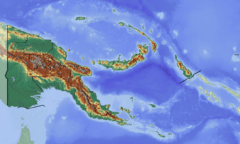Cophixalus nubicola facts for kids
Quick facts for kids Cophixalus nubicola |
|
|---|---|
| Conservation status | |
| Scientific classification | |
| Cophixalus nubicola is only known from Mount Michael in Papua New Guinea |
The Cophixalus nubicola is a small frog that belongs to the Microhylidae family. This special frog is found only in Papua New Guinea. It is known from just one place: Mount Michael in the Eastern Highlands Province. The name nubicola means "cloud dweller," which describes its home in the clouds. People sometimes call this frog the Michael rainforest frog.
About the Michael Rainforest Frog
Male Cophixalus nubicola frogs are about 22 to 24 millimeters (0.87 to 0.94 inches) long. Females are a bit bigger, growing up to 29 millimeters (1.1 inches) long. Their snout, which is like their nose area, is rounded.
The frog's eardrum, called the tympanum, can be seen but does not stick out much. It is partly hidden by a small fold of skin above it. Their fingers and toes have special sticky pads, or discs, which are more developed on their fingers. They do not have webbing between their fingers or toes.
The skin on their back is a bit bumpy, while their belly skin feels grainy. Their back is reddish-brown. Sometimes, they have a thin line down their back and light spots. Their belly often has light patches.
This frog is similar to another frog called Cophixalus parkeri. However, Cophixalus nubicola has shorter legs and less developed sticky pads on its fingers.
Where It Lives and How We Protect It
This frog was first found in a cloudy mountain rainforest and grassy areas on a ridge of Mount Michael. This area is very high up, about 3,100 meters (10,200 feet) above sea level.
Scientists have not found Cophixalus nubicola since it was first described, but there have not been many searches either. The forests high up on Mount Michael are facing challenges. Many people live in the lower areas nearby, and this can put pressure on the forest. Also, this frog is only known from one place, and that place is not a protected area like a national park. This makes it more important to keep an eye on its habitat.
See also
 In Spanish: Cophixalus nubicola para niños
In Spanish: Cophixalus nubicola para niños



